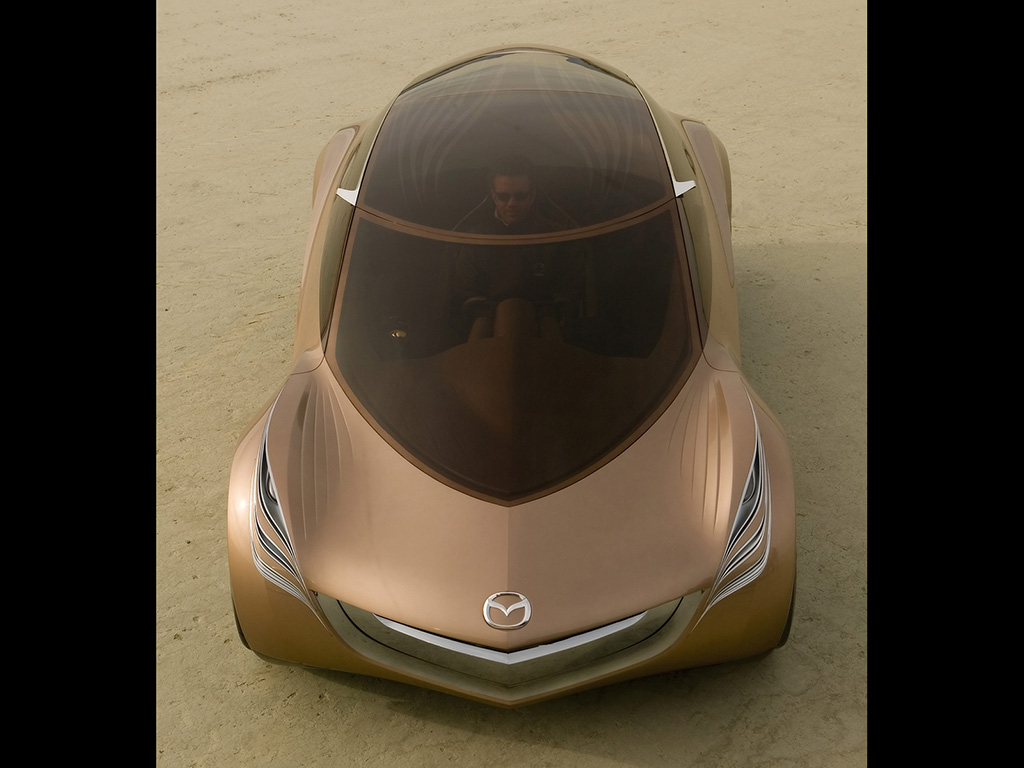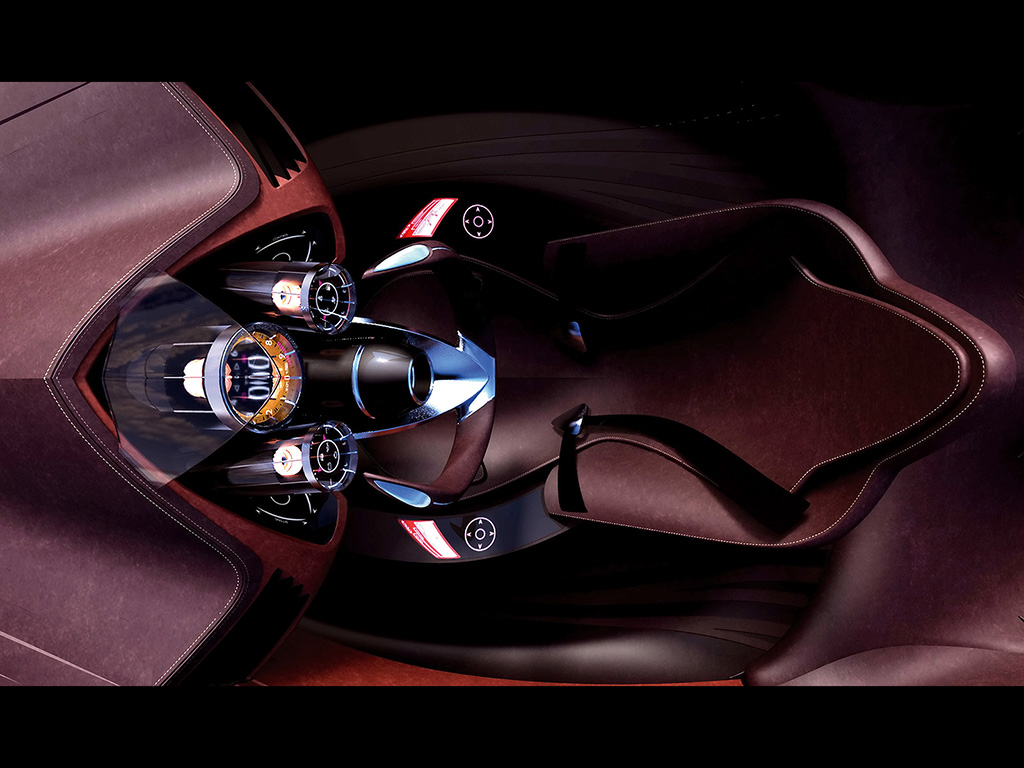2006 Mazda Nagare Concept
(From Mazda Press
Release) Mazda Nagare Concept: Capturing the Emotion of Motion in
new Surface Language
LOS ANGELES, 30th November 2006. After presenting three
ground-breaking concept vehicles during the 2005-2006 global auto
show season – Sassou at the 2005 Frankfurt Motor Show, Senku at the
2005 Tokyo Motor Show and Kabura at the 2006 Detroit Auto Show –
Mazda’s global design team wasn’t about to rest on its laurels. To
keep energy levels brimming, and to begin the process of evolving
Mazda’s design and surface language for future Zoom-Zoom vehicles,
Mazda’s design division has invented a new surface language called
Nagare for introduction at this year’s Los Angeles International
Auto Show.
NAGARE: (pronounced “na-ga-reh”) Japanese for ‘flow’ and the embodiment of motion.
Under the direction of Mazda’s new General Manager of the Design
Division, Laurens van den Acker, the challenge given to the team was
to invent a novel means of registering motion in vehicles whether
they’re moving or still. Nagare achieves that goal while also
signalling a fresh design direction for future Mazda vehicles.
Nagare is the first of a series of design concepts – some closer to
actual production vehicles than others – which Mazda will showcase
this global auto show season, including Los Angeles, Detroit, Geneva
and Tokyo.
Franz von Holzhausen, Mazda North American Operations’ (MNAO)
Director of Design, and the man responsible for leading the US-based
design team which developed this vehicle, explains, “We’re looking
well down the road with Nagare. We want to suggest where Mazda
design will be in 2020. To do that, we redefined basic proportions
and the idea of driving without losing the emotional involvement.
Mazda’s driving spirit will be enhanced and intensified by Nagare.”
“Mazda doesn’t produce concept cars to spin its wheels, and while
some are more forward-looking than others, we simply do not create
pure flights of fantasy. We develop these ideas to demonstrate what
we really intend to build and sell. It took soul-searching along
with basic research to invent the new surface language we’re calling
Nagare. The dynamic qualities of Mazda products already do an
excellent job of capturing the spirit of motion so our goal was to
move our design language a major step beyond what we’ve already
demonstrated with Sassou, Senku, and Kabura.”
Von Holzhausen continues, “We began by studying motion and the
effect it has on natural surroundings: how wind shapes sand in the
desert, how water moves across the ocean floor, and the look of lava
flowing down a mountainside. Natural motion registers an impression
in your brain and that’s what we hoped to capture with the new
Nagare surface language.”
“Once we started sketching our ideas, we weren’t surprised to find
similar quests underway in other product design disciplines. We
found examples of motion influencing the shape and surface of
furniture, architecture, apparel, and artwork. Nagare undoubtedly
proves our confidence in identifying a new and exciting visual
language for Mazda as we lead the way in defining the interaction of
motion and flow in automobile surfacing.”
“We began by developing a surface or textural language that
describes flow. The motion of the vehicle is defined by, and evident
in, the texture of its interior and exterior surfaces. There is no
right or wrong way to capture the impression of motion, so each of
the concepts we present throughout this global show season will
embody a different interpretation of our new surface language.”
CONCEPT OF A CONCEPT
Von Holzhausen describes Nagare as “a concept of a concept.” It’s
intentionally a celebration of proportions and surface language that
will evolve in subsequent designs planned for presentation at future
auto shows this season. In other words, design first, engineering
later at this point in the process, in contrast to the classic
‘form-follows-function’ approach.”
Adds van den Acker, “It’s important to start with the vision first:
Nagare is sculpture on wheels, our vision of what Mazda automobiles
could look like in 2020. The concept we’ll present in Detroit is
practical enough to produce in the next decade, while the model
under development for Geneva will embody design ideas we expect to
implement in the very near future.”
PACKAGE
Like all Mazda products, Nagare has the soul of a sports car. Its
shape is sleek and aerodynamically efficient, as you’d expect of an
urban cruiser for the future. Wheels are positioned at the far
corners of the envelope for quick steering response and agile
manoeuvrability. There isn’t an ounce of overhang wasted.
Access to the four-place interior is provided by two double-length
doors that hinge forward and up like the wings of a butterfly. The
driver is centrally located, like a single-seat sports racer, for
optimum control and visibility. Since the driver is positioned under
the highest portion of the roof, there’s ample headroom with a
comfortably reclined backrest. Innovative seating arrangements are a
Mazda specialty, as witnessed by the successful RX-8 four-passenger
sports car and the clever packaging in the upcoming CX-9 three-row,
seven-passenger crossover sport-utility vehicle.
Nagare’s rear compartment is a wrap-around lounge offering relaxed
accommodations for three passengers. The central front seat and
expansive door opening facilitate easy entry to the surprisingly
roomy interior.
Recognizing that an advanced design concept needs an advanced
powertrain, Nagare could conceivably be powered by a
hydrogen-fuelled rotary engine. Mazda’s work on this advanced
powertrain technology is among the most advanced in the world, with
hydrogen/gasoline-fuelled rotaries powering RX-8s currently in
service in Japan.
SURFACE TEXTURE REGISTERING FLOW MOTION
Nagare’s side surfaces provide a means of visualizing the air
flowing along and over the car as it speeds through the atmosphere.
Light and shadow combine to convey this feeling of motion even when
the car is standing still. Similar hints of fluid flow are evident
in the hood, wheel arches, LED head- and tail-lamp treatments. The
same surface language plays throughout Nagare’s interior; the
instrument panel, centre console, and door panels all appear to be
influenced by flow.
“Beauty is not a clean sheet of paper,” said von Holzhausen of the
vehicle. “Nagare’s motion-influenced surface texture compliments its
dynamic attributes. Because of Mazda’s sporty essence, we never wrap
our customers in boxes.
“Our new surface language is car-centric. After studying the
architectural approach, which tends to be strictly rigid, and the
organic approach, which is highly fluid, we created Nagare to
straddle those two disciplines. It is fluid, graceful, and dynamic.
But the message it registers on the beholder is flow-motion.”
GLOBAL DESIGN EFFORT
To give Mazda products sold in different global markets a common design theme, the three global design studios – located in Irvine, California, Frankfurt, Germany and Yokohama, Japan – are inspired, guided and encouraged by Laurens van den Acker, the firm’s global design director who is located at the company’s headquarters in Hiroshima, Japan. Future concepts embracing the Nagare flow design discipline will evolve under van den Acker’s oversight as this year’s show season unfolds.



